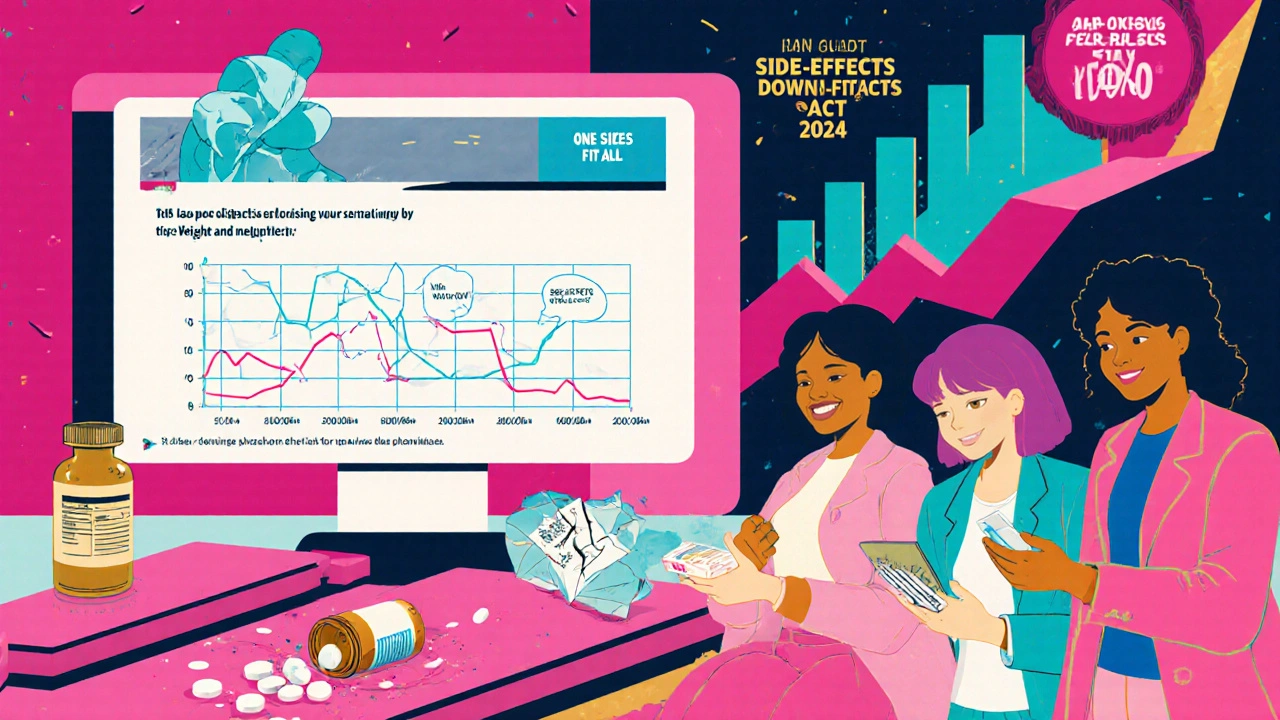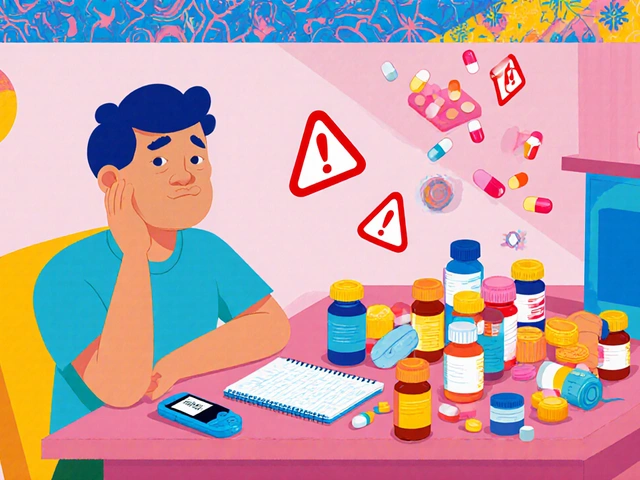Medication Dose Calculator for Women
How It Works
Most medications were developed using male-dominated clinical trials, leading to inappropriate dosing for women. This calculator shows recommended dose adjustments based on biological differences in metabolism, body composition, and hormonal factors.
Select Medication
Why Dosing Differs
Biological Factors
- 10-12% higher body fat (affects fat-soluble drugs)
- Lower liver enzyme levels (CYP3A4) which slows drug metabolism
- 20-25% slower kidney clearance for some drugs
- Hormonal fluctuations affecting drug processing
Results
Recommended Dose Adjustment
Zolpidem is metabolized 50% slower in women.
The FDA requires half the dose for women due to increased risk of drowsiness and accidents.
Women are nearly twice as likely as men to have a bad reaction to medication. It’s not because they’re more sensitive or complain more-it’s because most drugs were tested mostly on men, and the doses prescribed still reflect that outdated model. A woman taking the same pill as her husband might be getting too much, too often, and paying the price with dizziness, nausea, or worse.
Why Women Get Hit Harder by Drugs
The problem starts long before a prescription is written. For decades, clinical trials excluded women-especially those who could get pregnant-out of fear of harming a fetus. That policy, pushed by the FDA in the 1970s, meant that by the time a drug hit the market, doctors had almost no data on how it worked in women’s bodies. Even after the NIH mandated women’s inclusion in trials in 1993, the damage stuck. Today, only 12% of pharmacokinetic studies even look at how men and women process drugs differently.
Biologically, women aren’t just smaller versions of men. They have different body composition-on average, 10-12% more body fat and less muscle mass. That changes how drugs move through the body. Fat-soluble drugs like diazepam (Valium) linger longer in women, staying in the system 20-30% longer than in men. Women also have lower levels of key liver enzymes, like CYP3A4, which breaks down about half of all prescription medications. That means drugs like statins and benzodiazepines stay active longer, increasing side effects.
Then there’s the kidneys. Women clear some drugs, like lithium and certain antibiotics, 20-25% slower than men. Hormones add another layer: birth control pills can slash the effectiveness of the seizure drug lamotrigine by 50-60%. Even the menstrual cycle can shift how fast a drug is processed-some women metabolize medications 30% faster during ovulation than during their period.
Drugs That Hit Women Harder
It’s not theoretical. Real drugs, taken by real people, cause real harm because of these differences.
Zolpidem (Ambien) is the clearest example. In 2013, the FDA forced the manufacturer to cut the recommended dose for women by half-after years of data showed women were waking up groggy, driving while drowsy, and even falling asleep at the wheel. Why? Women metabolize zolpidem 50% slower than men. That’s not a coincidence-it’s biology. After the dose change, adverse event reports from women dropped by 38%.
Digoxin, used for heart failure, builds up to 20-30% higher levels in women at standard doses, raising the risk of dangerous heart rhythms. Women are 47% more likely than men to get a severe skin reaction from the antibiotic sulfamethoxazole. Antidepressants like sertraline and fluoxetine cause 1.5 to 2 times more nausea and dizziness in women. And women are 2.3 times more likely to develop a dangerous heart rhythm called QT prolongation when taking antipsychotics like haloperidol.
Even common painkillers aren’t safe. Studies show women report more side effects from ibuprofen and acetaminophen-even at standard doses-because their bodies handle them differently. And while men are more likely to suffer sexual side effects or urinary retention from anticholinergics, women bear the brunt of nearly every other category.
Who’s Getting Left Behind?
Women make up 51% of the U.S. population and take 59% of all prescription drugs. Yet only 4% of drug labels include sex-specific dosing instructions. That’s not a mistake-it’s a systemic failure.
Doctors don’t know what they don’t know. A 2022 survey found only 28% of physicians routinely consider sex differences when prescribing. Two-thirds didn’t even know about the FDA’s 2013 zolpidem dose change for women. And even when guidelines exist, they’re buried in fine print. Most prescriptions still use the same dose for everyone.
Patients notice. On Drugs.com, women taking sertraline reported 68% more severe nausea than men. On Reddit, nurses describe seeing twice as many women in the ER with reactions to standard painkiller doses. A 2022 survey of 15,000 chronic pain patients found women were more than twice as likely to stop taking opioids because side effects were too severe.
One woman on MyMedAssist.org wrote: “I took Ambien like my husband did-same dose, same time. Woke up every morning feeling like I’d been hit by a truck. I didn’t know it was supposed to be lower for women until my pharmacist asked if I’d ever read the label.”

The Bigger Picture: Cost, Risk, and Inequality
This isn’t just about discomfort-it’s about money and lives. Adverse drug reactions cost the U.S. healthcare system over $30 billion a year. Women account for 63-70% of those cases, even though they’re only half the population. That’s a staggering imbalance.
And it’s not just biological. Some experts argue that women are simply more likely to report symptoms and seek care. A Harvard study analyzing 33 million FDA reports found that once you account for the fact that women take more prescriptions (56% more, on average), the difference in adverse event rates shrinks to less than 5%. That doesn’t mean biology doesn’t matter-it means we’re missing half the story.
Dr. Janine Austin Clayton from the NIH puts it plainly: “Biological differences exist. But so does reporting bias. Women are more likely to talk about how they feel. And we need to listen.”
What’s Changing-and What’s Not
There are signs of progress. The FDA launched its “Sex and Gender Roadmap” in 2023, aiming to make sex and gender analysis standard in all drug approvals by 2026. The European Medicines Agency now requires sex-stratified data in Phase III trials. The NIH invested $12.5 million in a new research center at Harvard Medical School focused on sex differences in medicine.
Startups are stepping in too. Companies like Adyn and Womb Society are building drugs specifically for women’s physiology. The global women’s health pharma market is growing at 8.7% a year-though it’s still only 3.2% of the entire drug industry.
But change is slow. It took 21 years-from the first studies showing zolpidem’s sex difference in 1992-to the FDA’s dose reduction in 2013. And even now, only 15 of the 200 most commonly prescribed drugs have sex-specific dosing on their labels.
Researchers at UC Berkeley are running a study called JUST Dose, using AI to create personalized dosing rules for 50 common drugs based on sex, weight, and metabolism. Early results show a 40% drop in side effects when the new dosing is used. But until this becomes mandatory, most doctors won’t use it.

What You Can Do
If you’re a woman taking medication:
- Ask your doctor: “Was this dose tested on women?”
- Check the drug label for any mention of sex differences-especially for sleep aids, antidepressants, heart meds, and painkillers.
- Track your side effects. Keep a simple log: what you took, when, and how you felt. Bring it to appointments.
- If you’re having unexpected side effects, don’t assume it’s “just you.” It might be the dose.
If you’re a healthcare provider:
- Know the drugs with known sex differences: zolpidem, digoxin, lamotrigine, SSRIs, sulfamethoxazole.
- Consider starting women on lower doses, especially for drugs metabolized by the liver.
- Use the FDA’s “Drug Trials Snapshots” to see how men and women responded in clinical trials.
- Take free CME courses from the Organization for the Study of Sex Differences.
The Future Is Personalized
One-size-fits-all medicine is outdated. The data is clear: men and women are different-not just in hormones, but in how their bodies handle drugs. Ignoring that isn’t just lazy-it’s dangerous.
By 2035, if current trends hold, most new drugs will come with sex-specific dosing guidelines. The Fair Trials for Women Act, introduced in Congress in 2024, could make it law. Investors are pouring money into femtech. Patients are speaking up.
The goal isn’t to treat women as a problem to fix. It’s to treat them as the majority of patients they are. And that means giving them the right dose-the first time.
Why do women have more side effects from medications than men?
Women experience more side effects because most drugs were tested primarily on men, and dosing hasn’t been adjusted for biological differences. Women have slower liver metabolism, higher body fat, slower kidney clearance, and hormonal fluctuations that change how drugs are processed. For example, women metabolize zolpidem (Ambien) 50% slower than men, which led the FDA to cut the recommended dose for women by half in 2013.
What medications are known to affect women differently?
Common drugs with known sex-based differences include zolpidem (Ambien), digoxin, lamotrigine, SSRIs like sertraline and fluoxetine, sulfamethoxazole (an antibiotic), and certain heart medications like atenolol and verapamil. Women often need lower doses of these drugs to avoid side effects like dizziness, nausea, QT prolongation, and severe skin reactions.
Is it true that women take more medications than men?
Yes. Women take about 56% more prescription drugs than men on average. This is partly because they’re more likely to seek care for chronic conditions like depression, autoimmune diseases, and chronic pain. Higher usage increases exposure-and risk-of side effects, even if the drug itself isn’t inherently riskier for women.
Why don’t drug labels have sex-specific dosing?
Most drug labels still reflect dosing based on male-dominated clinical trials. Even though women make up nearly half of trial participants today, only 12% of pharmacokinetic studies analyze sex differences. Updating labels requires new data, regulatory review, and time-often over a decade. Only 4% of drug labels currently include sex-specific dosing recommendations.
Can I ask my doctor to lower my medication dose if I’m a woman?
Absolutely. If you’re experiencing side effects like dizziness, nausea, or fatigue from a medication, ask if the dose was tested on women or if a lower dose might be appropriate. For drugs like zolpidem, sertraline, or digoxin, starting lower is often safer. Your doctor can check the FDA’s Drug Trials Snapshots or consult pharmacokinetic data to make an informed decision.
Are there any new developments to fix this issue?
Yes. The FDA’s 2023 Sex and Gender Roadmap requires sex and gender data in all new drug reviews by 2026. The NIH has funded new research centers, and AI studies like JUST Dose are developing personalized dosing tools. The proposed Fair Trials for Women Act could make sex-specific dosing mandatory for all new drugs. These changes, combined with growing public awareness, are slowly shifting the system toward fairness.


